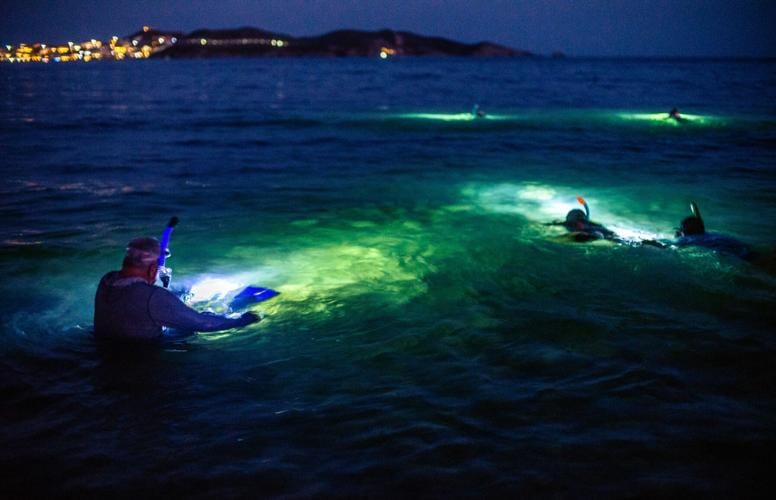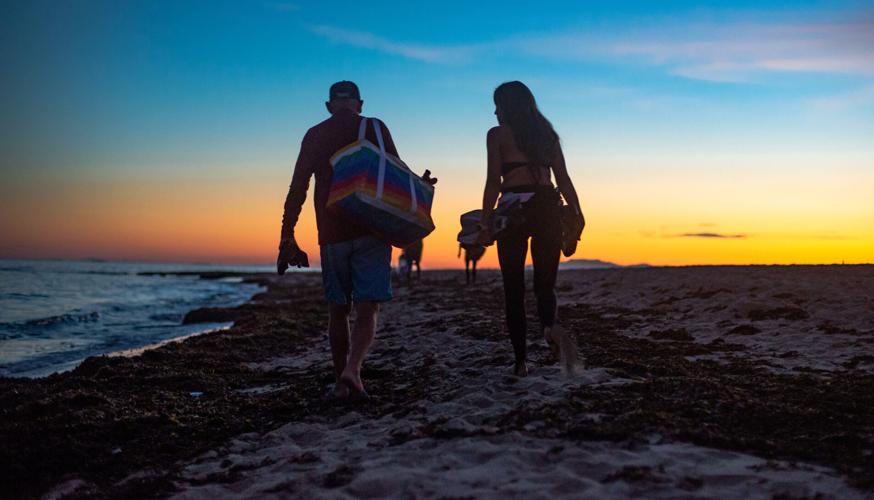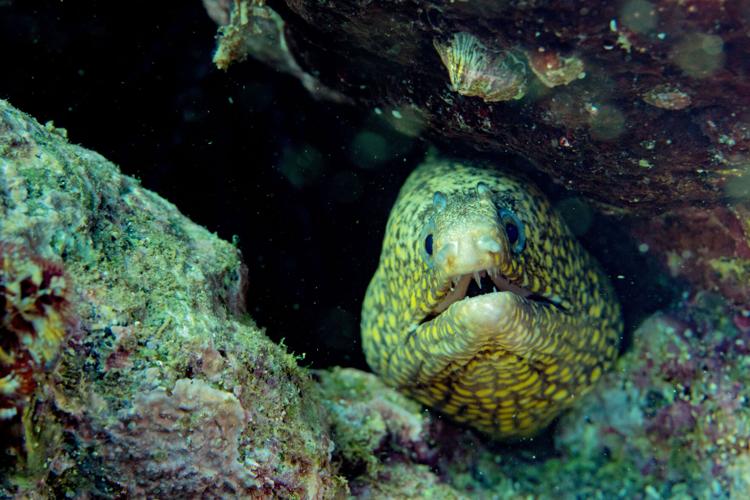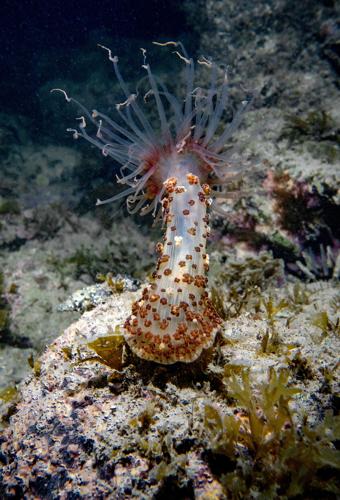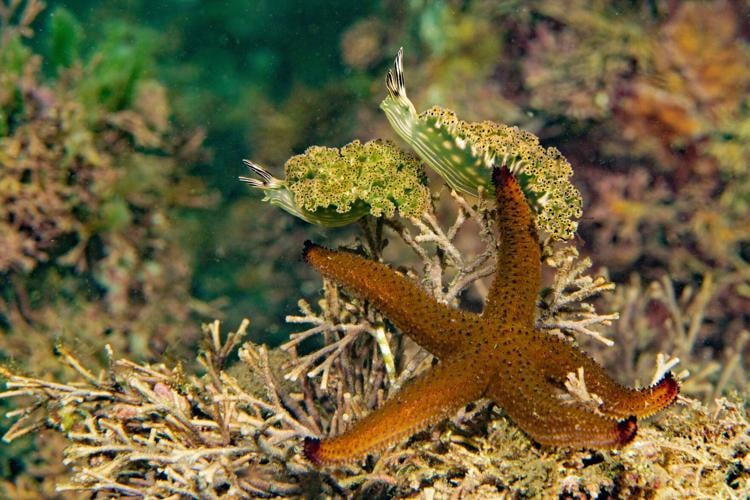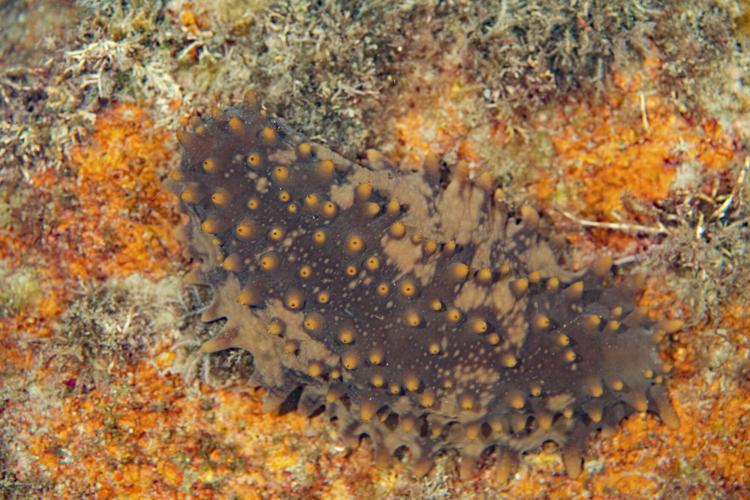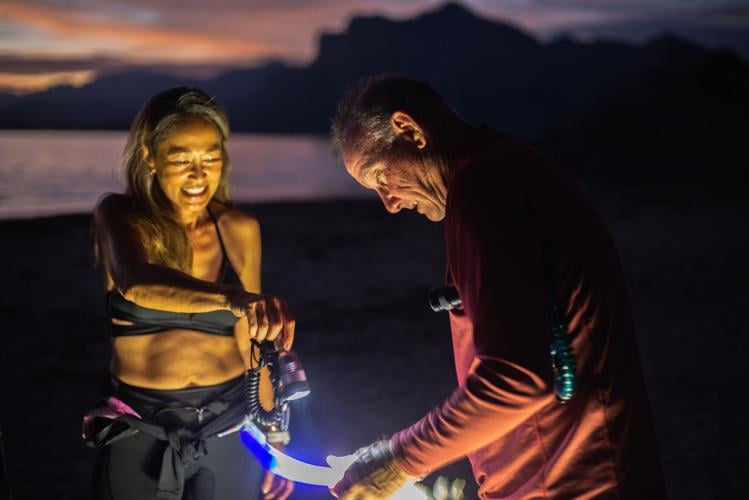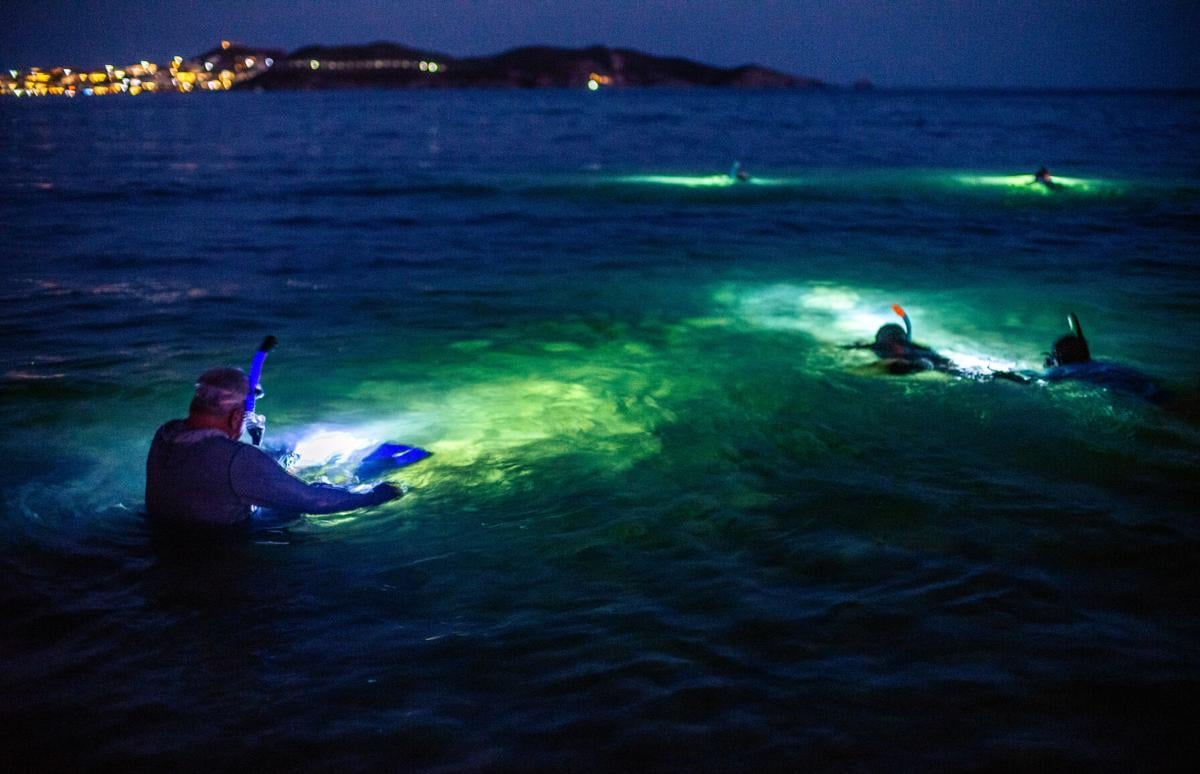SAN CARLOS, Sonora — Along the rocky shores of San Carlos, peering out of seaweed forests or fluttering silently across the seafloor, the weirdos of the sea emerge after sunset.
For biologists and environmental educators Stephanie Jo Bowman and Paul Hamilton — who lived in Tucson before moving onto their San Carlos-based sailboat in 2018 — that makes nighttime the perfect time to snorkel.
“All the cute, easy-to-love fish go to sleep, and all the weird invertebrates and other marine life come out,” said Bowman, who is also an artist and former Vail School District teacher. “Our special area of interest has always been the creepy, weird stuff that most people don’t really pay much attention to, or are freaked out by.”
The couple, who had their first date hiking in Sabino Canyon 12 years ago, share a love of overlooked and understudied species, and a passion for getting people interested in science.
In July, Bowman and Hamilton held a series of guided night-snorkel events in San Carlos, about 330 miles south of Tucson. The free gatherings were open to anyone who wanted to show up on the beach and brave the sea at night.
For San Carlos boat broker Marisa Velasco, who moved to San Carlos from California 18 years ago, night snorkeling wasn’t about the wildlife.

Walking along a seaweed-covered beach in San Carlos, Sonora, snorkelers Marisa Velasco, right, and Eric Fairfield follow Stephanie Jo Bowman and Paul Hamilton to a snorkeling area on July 1. Bowman and Hamilton, biologists and environmental educators, hope those who attend the night-snorkeling events feel empowered to continue exploring nature on their own, as “citizen scientists.”
“This is about conquering my fear,” she said as she prepared to enter the water with one of Bowman and Hamilton’s groups on a hot July night. “I’ve been (scuba) diving since I was 16, but I refused to go on night dives.”
She figured starting closer to the surface, with a group snorkel at a familiar beach, would be a good way to break through that mental barrier.
“I can do this,” she said, before stepping into the dark water.
Sailing for science
Bowman and Hamilton hope those who attend the night snorkeling events feel empowered to continue exploring nature on their own, as “citizen scientists.”
Hamilton founded the Tucson-based Biodiversity Group in 2003. His and Bowman’s work with the conservation nonprofit group took them around the world, from Ecuador to Vietnam to Mexico. They conducted research and promoted outdoor learning through a science-and-arts-focused curriculum that Bowman developed. (It has since been taught in after-school programs in the Sunnyside, Tucson Unified and Marana school districts, Bowman said.)
In 2018, the couple both stepped down from leadership roles with the nonprofit, rented out their Picture Rocks home and moved almost full time onto a sailboat in the Sea of Cortez.
San Carlos was a natural choice for their home base: The couple has been visiting the Sonoran beach town for more than a decade. Bowman said they were blown away by the unique “desert-meets-sea” environment, where one can have the surreal experience of surfacing from a dive and seeing cactus on the shore.
Like the “Sky Island” mountain ranges of southeastern Arizona and northern Mexico, the northern part of the Sea of Cortez is isolated, leading to new species — like the critically endangered vaquita porpoise — evolving for that unique ecosystem, Hamilton said.
In the southern part of the sea, “for as narrow a body of water as it is, the depth is incredible,” Bowman said. That creates a rich basin of nutrients for large species like humpback whales to feed on.

Before a July 1 night snorkeling session, Stephanie Jo Bowman briefs participants on what they’re likely to see underwater, displaying images from the book “Sea of Cortez Marine Invertebrates.” Bowman and her husband, biologist Paul Hamilton, are on a mission to introduce the public to overlooked and underappreciated species.
From here, Bowman and Hamilton say they’re well-positioned to pursue one of their missions: introducing the public to overlooked species, including strange-looking invertebrates and nocturnal marine life.
“Those species are what hold the ecosystems together,” Bowman said. “Humans lose so much by not being connected to the little stuff that’s so easy to see and to share the world with.”
Finding and observing overlooked species doesn’t require an epic journey or exotic destination; a kid with a magnifying glass can discover a jungle in the school playground, Bowman said.
“Just go out in your backyard, or snorkel in the bay right here, to see incredible life that most people just overlook,” she said.
The couple also offers boat rides — they call it “sailing for science” — on their trimaran “Triplefin,” the name a reference to the vessel’s three hulls and a tribute to triplefin blennies, a fish with three dorsal fins that’s extremely common, yet understudied, Bowman said.
Bowman and Hamilton plan to visit friends and family in the U.S. for the rest of the summer, but will restart their night snorkeling session in the fall, when they return to Mexico.

A jewel moray eel checks out a passing snorkeler during a night dive near San Carlos, Sonora. Photo taken with a Sony Alpha digital camera and 90 mm lens.
The ‘rocks’ have eyes
On a recent July evening in San Carlos, Bowman and Hamilton spoke to their night-snorkeling group on the beach in front of the Soggy Peso restaurant, near the small Isla San Luis where they’d be snorkeling.
As the sun set behind them, Bowman paged through a dog-eared copy of “Sea of Cortez Marine Invertebrates,” describing the creatures to look for, and which to avoid, in the dark sea.
Among the vertebrates to watch for: stone scorpionfish. Disguised as seaweed-covered rocks, they’re hard to spot as they wait for their prey.
“Their eyes are like other worlds when you look into them. It’s mesmerizing,” Bowman told the group. But those eyes should serve as a warning to snorkelers, she said; their spines are venomous.
“If you go to grab a rock, just make sure it doesn’t have eyes,” she said.
Sea cucumbers
One of the most important, and imperiled, creatures that snorkelers would encounter that night: the brown sea cucumber.
Sea cucumbers perform a crucial purifying function, cleaning the seas by ingesting sea water and sediment, before excreting clean sand.
“Sea cucumbers are not the prettiest animal, but they have a very important role in the ecosystem,” said Alejandro Olivera, senior scientist and Mexico representative for the Center for Biological Diversity.
But the mostly sedentary creatures are being hunted, dried and salted, and shipped en masse to China, where they are considered a tasty aphrodisiac and increasingly, a status symbol.

A sea cucumber inches along the seafloor, helping to perform a crucial purifying function by ingesting sea water and sediment before excreting clean sand.
A lucrative market has developed over the past few decades, fueling a hunt that is decimating the sea cucumber population in Mexico, including in the Sea of Cortez, Olivera said in an interview.
When they were first listed under Mexico’s Endangered Species Act in 1994, brown sea cucumbers had “special protection” status, the lowest level of protection, coming before the “threatened,” “at risk of extinction” and “extinct” levels.
Two years ago, the sea cucumber was moved up to threatened status, Olivera said.
Protected species are regulated by the Ministry of Environment who can set quotas for legal hunting limits and create a management plan, but regulation is weak and enforcement sporadic, he said.
Those with legal permits often hunt more than they’re allowed, and others just hunt illegally, he said. Sea cucumbers don’t reach sexual maturity until about 6 years old, and many are killed before they can reproduce, he said.
“There is no management plan, even though they have been protected for decades, and the population is depleting,” Olivera said.
That decline is obvious to snorkelers, Bowman said. Ten years ago in San Carlos, “you wouldn‘t be able to look at the bottom without seeing at least several sea cucumbers in your view,” she said. “And now it’s like you have to hunt to find one.”

This nocturnal anemone shrinks down to a disk during the day but shows its splendor during a night snorkel or dive.
Shortly before dark, Bowman emphasized to the night snorkeling group that they should not touch anything unless they are absolutely sure it’s safe to touch.
For example: As long as your hands are free of bug spray and sunscreen, it’s all right to gently pet a brown sea cucumber — but do not pick it up, Bowman said. If it feels threatened, a sea cucumber’s defense mechanism can be traumatic: it spews out its intestines to distract predators.
The sticky sea cucumber is another story: even a small touch could be disastrous. Their long bodies are scrunched up tight “like accordions,” Bowman said, and so sticky that a touch could tear its skin.
“You could kill it just by touching it,” she said.
This night, San Carlos resident A de la Maza Perez Tamayo and her son Axan, 9, were out for their second night snorkeling with Bowman and Hamilton.
“It’s my favorite type of snorkeling now,” said de la Maza Perez Tamayo, who works in the sociolinguistics field. “All the creatures of the ocean seem a lot more relaxed. The fish are a lot less jittery, they’ll swim up really close to you.”
And the timing is perfect for her Axan, who would rather boogie-board in the day. All his favorite creatures — the ones that “look like aliens” — come out at night, she said.
“He’s always been incredibly interested in the creepy crawlies,” she said. “I’ve always liked that he’s able to see beauty in unconventional things.”
Axan, who wants to be a marine biologist, was on a mission.
“I want to see moray eels,” said Axan, as he followed Bowman and Hamilton toward the snorkeling site.
Risks of the night
The gentle hum of waves and the cracking of snapping shrimp — whose powerful, tiny claws snapping shut can be heard up to a kilometer away — were the only sounds for those out on another night snorkel. This time, Bowman and Hamilton led snorkelers to a beach called Shangri-La, near Marinaterra Beach Club in San Carlos.
The underwater ecosystem was buzzing with life, under the glow of snorkelers’ dive lights.

Two sea slugs out at night atop a sea star off San Carlos, Sonora.
Illuminated in a green cone of light, a finger-sized fire worm floated vertically, its fuzzy-looking body belying the potential for a fiery sting. A red-and-white striped zebra worm, which can expand up to 8 meters in length, was tucked amidst the sea rocks, a living puzzle with no clear beginning or end.
A reef stingray, like a spotted brown pancake, fluttered just above the seafloor, eyeing the snorkeler above. Balloonfish and parrot fish, normally skittish during the day, calmly slept or observed the visitors.
Hamilton gently held a hairy-looking brittle star, closely related to the starfish. Later, a delicate arrow crab — so thin it looked like an aquatic daddy longlegs — danced around Hamilton’s fingers. Then, drawing its legs together like an octopus, it propelled itself away like an arrow.
Bowman even managed to alert her fellow snorkelers to a brown sea cucumber, its plump dorsal side covered with a sprinkling of small yellow protrusions.
Snorkelers who turned off their flashlights saw the electric-green lights of tiny, bioluminescent plankton, whose glow crackled to life with each wave of the hand through the water.
But there are drawbacks to the darkness: It’s harder to see potential threats. Though wearing a long-sleeve shirt, Hamilton was stung on the neck and wrist by a Portuguese man-o-war, a relative of the jellyfish, at the end of this snorkeling session.
On the rocky shore, Bowman carefully pulled the bright-blue tentacles from Hamilton’s wrist using the pads of her fingers, where the skin is too tough for tentacles to penetrate.
Smiling despite his discomfort, Hamilton said he was relieved he was the unlucky one that night.
Conquering a fear
After her first-ever night snorkel, Velasco declared victory over her fear of night diving.
“I’m happy to report that I basically got over it,” she said by phone. “It was familiar; it’s like snorkeling in your own backyard. I was like, ‘If I’m going to conquer this, it’s going to be someplace where I’m comfortable.’”

Marisa Velasco, left, and her diving partner Eric Fairfield prepare to enter the water for a night snorkeling session. While she’s been scuba diving since she was 16, Velasco said she’s never gone at night. “This is about conquering my fear,” she said.
She had searched carefully for all the species Bowman had described in their prep session on the beach.
“Within 15 minutes, we found just about everything she said we were going to find,” she said.
Among her most exciting sightings: the cowrie, a colorful snail that lives in a smooth shell, with a narrow mouth-like opening. In the daytime, the snail is hidden inside, but at night, cowries come outside of their shell and wrap their brightly-colored bodies around it, so that the shell almost becomes an internal skeleton, Bowman said.
A native of the Philippines, Velasco said she previously found day-time snorkeling in this desert region to be underwhelming compared to the vibrant colors of the tropics.
But at night, illuminated by flashlight, the desert colors glowed with unusual vibrance, she said.
The sea at night “was way more alive than I was expecting it to be,” Velasco said.
Nine-year-old Axan had an “amazing” time, said his mom, de la Maza Perez Tamayo. He saw octopus, a ton of very active starfish and his favorite, a moray eel.
“I could hear him squeal underwater” when he spotted one, she said. “He’s absolutely obsessed with eels.”
Existential dilemmas
Hamilton, a field biologist whose specialty is herpetology, believes most children are naturally fascinated by “creepy, crawly things.”
“I was born interested in lizards,” he said. “Some of us grow up thinking that’s not cool, because someone taught us that. … A lot of that imagination and that innate curiosity is kind of beaten out of us as kids. We need advocates out there who are willing to stand up and say, ‘This is awesome. This is worthwhile.’”
As a rising tide of anti-science propaganda seems to be moving toward the mainstream, politicizing the debate over crucial issues like climate change and the COVID-19 pandemic, scientists are facing an existential dilemma, Hamilton said.
“It’s just tragic that we can’t use facts. We can’t use sound arguments,” he said. “We can’t use much of anything that I would be able to provide (as a scientist). … Where does that leave someone like me?”
The spread of misinformation as it relates to the pandemic has both a professional and personal dimension for the couple: Bowman and Hamilton both lost loved ones in the pandemic. Hamilton’s father died of COVID-19 in January, and the recent death of Bowman’s sister is suspected to be related to the virus.
In May, Hamilton wrote a blog post exploring the existential malaise that arises when one’s life work sometimes seems without purpose. He recounted a recent experience that helped him cope.
In his post, Hamilton describes how he encountered, and rescued, a humpback whale caught in a massive fishing net in the southern Sea of Cortez. Bowman’s video of the rescue went a little viral this summer and for a few days, Hamilton had people from all over the world calling him a hero.
It was a privileged experience, he said: the chance to do something “unambiguously good,” with clarity of purpose — a far cry from the often thankless work of scientists in the trenches.
The whale rescue “was one hour of work. It was a lot easier than writing a grant,” he said with a laugh. Instead, “talk about working for 10 years on something, or one year, and all of these people out here who aren’t ever going to be called heroes — including me, the day before that.”
So how can scientists help renew public discourse? Night snorkeling may be a start.
Shared adventures in nature can help transcend political tribalism, leading to conversation and connection, Bowman said.
“We have so much more in common,” Bowman said. “None of us want to see species go extinct. No one wants to see that. So just getting out there together, and sharing some experiences, I think will help us heal some of these divides.”
For those fighting a sense of environmental fatalism, Bowman says the best way to cope is by taking some action — even something as simple as organizing some friends for a new experience.
“Do something,” she said. “Do something, even if you can’t see where that end is going to be. Don’t just turn on the TV and drink a beer and tune it out, which is so easy to do — and I do it some.”
Instead, she said, “just get out there and let yourself be moved by the beauty of this planet.”
Photos: Sea creatures at night just below the surface of the Sea of Cortez
Night diving, Sea of Cortez, San Carlos
Updated
An arrow crab posed in front of a sea fan while diving at night in the Sea of Cortez near San Carlos, Mexico.
Night diving, Sea of Cortez, San Carlos
Updated
Diving at night in the Sea of Cortez near San Carlos, Mexico.
Night diving, Sea of Cortez, San Carlos
Updated
Seahorses are the some of the rarest and awesomest creatures around San Carlos
Night diving, Sea of Cortez, San Carlos
Updated
Diving at night in the Sea of Cortez near San Carlos, Mexico.
Night diving, Sea of Cortez, San Carlos
Updated
Spiny lobsters are not only for food, but are works of art as well. Diving at night in the Sea of Cortez near San Carlos, Mexico.
Night diving, Sea of Cortez, San Carlos
Updated
A parrot fish wraps itself up in mucous to protect itself at night
Night diving, Sea of Cortez, San Carlos
Updated
A close of a venomous flower sea urchin, showing tube feet and stinging disk seen while night scuba diving in San Carlos, Mexico
Night diving, Sea of Cortez, San Carlos
Updated
Diving at night in the Sea of Cortez near San Carlos, Mexico.
Night diving, Sea of Cortez, San Carlos
Updated
Diving at night in the Sea of Cortez near San Carlos, Mexico.
Night diving, Sea of Cortez, San Carlos
Updated
Diving at night in the Sea of Cortez near San Carlos, Mexico.
Night diving, Sea of Cortez, San Carlos
Updated
Diving at night in the Sea of Cortez near San Carlos, Mexico.
Night diving, Sea of Cortez, San Carlos
Updated
Diving at night in the Sea of Cortez near San Carlos, Mexico.
Night diving, Sea of Cortez, San Carlos
Updated
Diving at night in the Sea of Cortez near San Carlos, Mexico.
Night diving, Sea of Cortez, San Carlos
Updated
An octopus out hunting at night in the Sea of Cortez near San Carlos, Mexico
Night diving, Sea of Cortez, San Carlos
Updated
Tiny spectacular nudibranchs (a relative of sea slugs) are treats for the patient observer while diving at night in San Carlos, Mexico
Night diving, Sea of Cortez, San Carlos
Updated
Diving at night in the Sea of Cortez near San Carlos, Mexico.
Night diving, Sea of Cortez, San Carlos
Updated
A moray eel sporting a fish hook while diving at night in the Sea of Cortez near San Carlos, Mexico.


